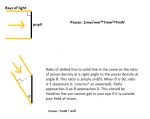- Joined
- Sep 12, 2007
- Messages
- 9,399
- Points
- 113
Well, that brings up another point. What are the chances the sun will be directly where you are looking the millisecond you open the door? If it's not directly on the fovea, you have to incorporate trigonometry, and the exposure is reduced.
So what if you exited theaters that face the sun and are stupid about where you direct your gaze? The point still stands the sun's focal point is much larger than a laser's focal point. You cannot equate 25mW of sunlight or fluorescent light with laser light.
So what if you exited theaters that face the sun and are stupid about where you direct your gaze? The point still stands the sun's focal point is much larger than a laser's focal point. You cannot equate 25mW of sunlight or fluorescent light with laser light.






